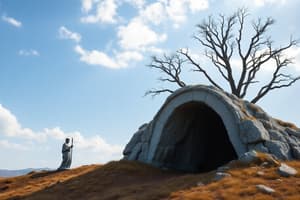Podcast
Questions and Answers
What metaphor does Plato use in the Allegory of the Cave to illustrate his philosophical concepts?
What metaphor does Plato use in the Allegory of the Cave to illustrate his philosophical concepts?
Plato uses the metaphor of prisoners chained in a cave who only see shadows on the wall.
How do the captives in the cave perceive reality?
How do the captives in the cave perceive reality?
The captives perceive reality only through the shadows cast on the wall, never seeing the actual objects.
What does the fire represent in the Allegory of the Cave?
What does the fire represent in the Allegory of the Cave?
The fire represents the source of light and truth, illuminating the shadows played out before the captives.
What is the significance of the low partition in the cave analogy?
What is the significance of the low partition in the cave analogy?
What conclusion can be drawn about the captives' understanding of the names they give to the shadows?
What conclusion can be drawn about the captives' understanding of the names they give to the shadows?
In what way does Glaukon's agreement with Socrates contribute to the dialogue?
In what way does Glaukon's agreement with Socrates contribute to the dialogue?
How does the allegory challenge superficiality and materialism?
How does the allegory challenge superficiality and materialism?
What does the Allegory of the Cave suggest about the process of learning?
What does the Allegory of the Cave suggest about the process of learning?
What do the shadows represent in the allegory described by Socrates?
What do the shadows represent in the allegory described by Socrates?
How does the experience of the freed prisoner differ from that of the captives in the cave?
How does the experience of the freed prisoner differ from that of the captives in the cave?
What challenges does the freed prisoner face when exposed to light?
What challenges does the freed prisoner face when exposed to light?
In what way does Socrates suggest that the journey to understanding reality is gradual?
In what way does Socrates suggest that the journey to understanding reality is gradual?
What would the freed prisoner initially see after emerging from the cave, according to Socrates?
What would the freed prisoner initially see after emerging from the cave, according to Socrates?
How does Glaukon respond to Socrates' description of the freed prisoner's experience?
How does Glaukon respond to Socrates' description of the freed prisoner's experience?
What implications does Socrates suggest regarding the acceptance of new knowledge?
What implications does Socrates suggest regarding the acceptance of new knowledge?
What does Socrates indicate about the nature of enlightenment in relation to the sun?
What does Socrates indicate about the nature of enlightenment in relation to the sun?
Flashcards
Plato's Cave Analogy
Plato's Cave Analogy
Plato uses the metaphor of prisoners chained in a cave who can only see shadows on the wall to illustrate his philosophical ideas.
Captives' Perception of Reality
Captives' Perception of Reality
The captives in the cave perceive reality only through the shadows cast on the wall, never seeing the actual objects.
Fire in the Cave Metaphor
Fire in the Cave Metaphor
The fire represents the source of light and truth, illuminating the shadows played out before the captives.
The Low Partition
The Low Partition
Signup and view all the flashcards
Names and Shadows
Names and Shadows
Signup and view all the flashcards
Glaukon's Agreement
Glaukon's Agreement
Signup and view all the flashcards
Challenging Superficiality
Challenging Superficiality
Signup and view all the flashcards
Learning and the Cave
Learning and the Cave
Signup and view all the flashcards
Meaning of Shadows
Meaning of Shadows
Signup and view all the flashcards
Freed Prisoner's Experience
Freed Prisoner's Experience
Signup and view all the flashcards
Challenges of Exposure to Light
Challenges of Exposure to Light
Signup and view all the flashcards
Gradual Journey to Reality
Gradual Journey to Reality
Signup and view all the flashcards
The First Sight
The First Sight
Signup and view all the flashcards
Glaukon's Response
Glaukon's Response
Signup and view all the flashcards
Acceptance of New Knowledge
Acceptance of New Knowledge
Signup and view all the flashcards
Enlightenment and the Sun
Enlightenment and the Sun
Signup and view all the flashcards
Study Notes
Overview of Plato's Allegory of the Cave
- Written around 380 BCE, part of "The Republic" and illustrates idealism.
- Metaphor for human perception, superficiality, and materialism.
The Cave and Its Inhabitants
- Captives are chained in a dark cave from birth, unable to move or see behind them.
- They can only see shadows cast on the wall from objects behind a low partition.
- Shadows represent limited understanding of reality.
The Role of the Light and the Fire
- A fire blazes behind the captives, casting shadows that they interpret as reality.
- Objects carried by individuals behind the partition create these projections, influencing the captives' beliefs.
Perception of Reality
- Captives would only know the shadows and believe those are the real things.
- Any sound they hear would be associated only with the shadows, reinforcing their misconceptions.
The Process of Enlightenment
- One captive is released and struggles to adjust to his newfound freedom.
- Initially blinded by the light, he finds it painful to transition from shadows to reality.
- The gradual process involves recognizing reflections, real objects, and eventually the sun.
The Sun as a Symbol
- Represents the ultimate truth and knowledge.
- Captives’ journey symbolizes the philosophical path from ignorance to enlightenment.
Human Nature and Resistance
- Released captives may still cling to former beliefs, thinking shadows were more real.
- Resistance to enlightenment illustrates human nature's reluctance to accept challenging truths.
Philosophical Implications
- The allegory highlights the journey of the philosopher from ignorance to knowledge.
- It suggests that most people live in ignorance, mistaking shadows for reality.
- Promotes the importance of education and the pursuit of deeper understanding.
Studying That Suits You
Use AI to generate personalized quizzes and flashcards to suit your learning preferences.




